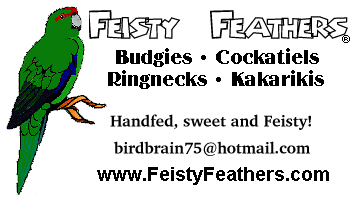

I get plenty of letters from people in Samís situation. There is never anything wrong with the
bird, itís just that the owner is not being aggressive enough.
So just what is assertive taming?
Step One: Brief Adjustment Period
The first thing most people do when they buy a new bird is give it time to "adjust." Birds,
like humans, are creatures of habit and do not like change. This does not mean that they canít
handle it though. An adjustment period is fine but the problem is that most people donít know
when to end it. Give the bird one full day to get used to its surroundings, then start your
taming. Even handfed birds will be uncomfortable in a new home. A bird needs to know it is
safe. It will not learn this locked up in a cage with no interaction. Birds are social and
feel safest in a flock. It is your job to welcome the bird into the family "flock." Most shy
handfeds perk right up when taken out and played with.
Step Two: Get it Away From the Cage
Birds that are tamed within the cage or left inside it for long adjustment periods will become
cage bound. Cage bound birds may eventually learn to enjoy human company but they will never
want to leave their cage. This is very unhealthy. After the ONE DAY adjustment take the bird
out of the cage. Ignore the protests and nips, just get it out of there and into a completely
different room. Do not attempt to tame a bird within view of a cage because it will be obsessed
with getting to the cage and not pay any attention to you. Bathrooms and closets work great as
taming areas because they are confined and have very little furniture for birds to hide under.
Step Three: Make it Interact With You
Now that youíre away from the cage in a small room the bird has no choice but to be near you.
This doesnít mean it canít still keep from interacting with you. How fast you choose to
take the next step is up to you and depends on how wild or frightened the bird is. You can work
on the stick training method now. You can keep the bird in a corner,
talk to it and try to touch it. You can wrap it up in a towel/shirt and hold it in your lap,
gently unwrapping it as it calms down. T-stands come in very handy. You can set the bird on
one, talk to it and offer treats.
Step Four: Keep all Interactions Pleasant
The object is to show the bird that hanging out with people has its rewards. Try to end all
sessions on a positive note and try not to get frustrated. Bites will occur but most birds turn
to mock bites once they realize you are not posing any real danger. Give treats the bird likes.
Peanuts and sunflowers are high in fat and should not be included in a regular diet. They make
good treats though. Also try bribing the bird with juicy fruit. I had a conure who went after
grapes and cherries with gusto. Give head scratches. Let the bird play with some neat toys.
Step Five: Do Not Allow Cage Binding
This is the final step. Once the bird is relatively calm around people get it a playstand. At
first keep it on or around the cage. A healthy bird will view its cage like we would a bedroom:
a place to sleep and hang out but not somewhere youíd want to be all the time. The playstand is
a way for the bird to be near its cage but keep it out just the same. Once the bird learns to
enjoy being out you should be able to take it anywhere in the house without it getting
frightened.

All articles and images contained on this site are © 1998, 1999 by Feisty Feathers unless otherwise noted and may not be reprinted or used in any way without the author's permission.